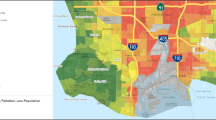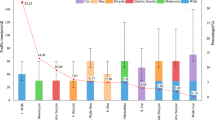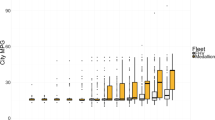Abstract
Motor vehicles are the main source of many hazardous air pollutants in California. Previous studies have shown that low-income and minority populations are more likely to live near industrial sources of pollution and in areas that do not meet national air quality standards. We estimated neighborhood exposures to motor vehicle emissions from a road network with daily traffic counts using a geographic information system. To calculate traffic density, we summed the average daily vehicle miles of travel per square mile of land area for each census block group in the state. We used 1990 census data to characterize the population by age, race and socioeconomic status in block groups with high traffic density. Block groups with more than 500,000 vehicle miles of travel per square mile were defined to be high traffic density. Statewide, about 5% of all block groups met this criterion and more than 215,000 children under 15 years of age lived in these high traffic density areas. Block groups in the lowest quartile of median family income were three times more likely to have high traffic density than block groups in the highest income quartile. The percentage of children living in high traffic density block groups increased with decreasing median family income for all race and ethnicities except White. Overall, children of color were about three times more likely to live in high-traffic areas than were white children. Based on this analysis, low-income and children of color have higher potential exposure to vehicle emissions. Future exposure assessment studies should target the highest traffic density areas, and health studies should consider the differences by income and race or ethnicity during design.
This is a preview of subscription content, access via your institution
Access options
Subscribe to this journal
Receive 6 print issues and online access
$259.00 per year
only $43.17 per issue
Buy this article
- Purchase on Springer Link
- Instant access to full article PDF
Prices may be subject to local taxes which are calculated during checkout





Similar content being viewed by others
Abbreviations
- AADT:
-
annual average daily traffic
- CALTRANS:
-
California Department of Transportation
- GIS:
-
geographic information system
- SES:
-
socioeconomic status
- VMT:
-
vehicle miles traveled
References
Bellander T., Berglind N., Gustavsson P., Jonson T., Nyberg F., Pershagen G., and Jarup L. Using geographic information systems to assess individual historical exposure to air pollution from traffic and house heating in Stockholm. Environ Health Perspect 2001: 109 (6): 633–639.
Briggs D.J., de Hoogh C., Gulliver J., Wills J., Elliott P., Kingham S., and Smallbone K. A regression-based method for mapping traffic-related air pollution: application and testing in four contrasting urban environments. Sci Total Environ 2000: 253: 151–167.
Brunekreef B., Janssen N.A.H., de Hartog J., Harssema H., Knape M., and van Vliet P. Air pollution from truck traffic and lung function in children living near motorways. Epidemiology 1997: 8: 298–303.
California Air Resources Board. Measuring concentrations of selected air pollutants inside California vehicles. (Report No.: 95-339) California Air Resources Board, Research Division, Sacramento, CA, 1998.
California Air Resources Board. The 1999 California almanac of emissions and air quality. California Air Resources Board, Planning and Technical Support Division, Sacramento, CA, 1999a.
California Air Resources Board, Air quality data branch. California ambient air quality data 1980–1998 [data file]. California Air Resources Board, Sacramento, CA, 1999b.
California Air Resources Board. California toxics inventory for 1996. [Web Page] 2000; http://www.arb.ca.gov/toxics/cti/cti.htm. [Accessed 24 January 2001].
California Department of Transportation. Highway performance and monitoring system [data file] California Department of Transportation, Sacramento, CA, 1993.
California Department of Transportation, Traffic operations division. Historical monthly vehicle miles of travel report. [Web Page] 2001 [Accessed 27 December 2002].
Ciccone G., Forastiere F., and Agabiti N. Road traffic and adverse respiratory effects in children. SIDRIA Collaborative Group. Occup Environ Med 1998: 55 (11): 771–778.
Dubowsky S., Wallace L., and Buckley T. The contribution of traffic to indoor concentrations of polycyclic aromatic hydrocarbons. J Expo Anal Environ Epidemiol 1999: 9 (4): 312–321.
Duhme H., Weiland S.K., Keil U., Kraemer B., Schmid M., Stender M., and Chambless L. The association between self-reported symptoms of asthma and allergic rhinitis and self-reported traffic density on street of residence in adolescents. Epidemiology 1996: 7: 578–582.
English P., Neutra R., Scalf R., Sullivan M., Waller L., and Zhu L. Examining associations between childhood asthma and traffic flow using a geographic information system. Environ Health Perspect 1999: 107 (9): 761–767.
Feychting M., Svensson D., and Ahlbom A. Exposure to motor vehicle exhaust and childhood cancer. Scand J Work Environ Health 1998: 24 (1): 8–11.
Harrison R.M., Leung P., Somervaille L., Smith R., and Gilman E. Analysis of incidence of childhood cancer in the West Midlands of the United Kingdom in relation to proximity to main roads and petrol stations. Occup Environ Med 1999: 56: 774–780.
Kinney P.L., Aggarwal M., Northridge M.E., Janssen N.A.H., and Shepard P. Airborne concentrations of PM2.5 and diesel exhaust particles on harlem sidewalks: a community-based pilot study. Environ Health Perspect 2000: 108 (3): 213–218.
Knox E.G., and Gilman E.A. Hazard proximities of childhood cancers in Great Britain from 1953–1980. J Epidemiol Community Health 1997: 51: 151–159.
Kono K., and Ito S. A micro-scale dispersion model for motor vehicle exhaust gas in urban areas – OMG volume–source model. Atmos Environ 1990: 24B (2): 243–251.
Korc M.E. A socioeconomic assessment of human exposure to ozone in the south coast air basin of California. J Air Waste Manage Assoc 1996: 46: 547–557.
Langholz B., Ebi K., Thomas D., Peters J., and London S. Traffic density and the risk of childhood leukemia in a Los Angeles case-control study. Ann Epidemiol 2002: 12 (7): 482–487.
Morello-Frosch R., Pastor M., Porras C., and Sadd J. Environmental justice and regional inequality in southern California: implications for future research. Environ Health Perspect 2002: 110 (Suppl 2): 149–154.
Nakai S., Nitta H., and Meada K. Respiratory health associated with exposure to automobile exhaust II. personal NO2 exposure levels according to distance from the roadside. J Expo Anal Environ Epidemiol 1995: 5 (2): 125–136.
Neumann C.M., Forman D.L., and Rothlein J.E. Hazard screening of chemical releases and environmental equity analysis of populations proximate to toxic release inventory facilities in Oregon. Environ Health Perspect 1998: 106 (4): 217–226.
Nordlinder R., and Jarvholm B. Environmental exposure to gasoline and leukemia in children and young adults – an ecology study. Int Arch Occup Environ Health 1997: 70: 57–60.
Oosterlee A., Drijver M., Lebret E., and Brunekreef B. Chronic respiratory symptoms in children and adults living along streets with high traffic density. Occup Environ Med 1996: 53 (4): 241–247.
Pearson R., Wachtel H., and Ebi K. Distance-weighted traffic density in proximity to a home is a risk factor for leukemia and other childhood cancers. J Air Waste Manage Assoc 2000: 50 (2): 175–180.
Perlin S.A., Setzer R.W., Creason J., and Sexton K. Distribution of industrial air emissions by income and race in the United States: an approach using the toxic release inventory. Environ Sci Technol 1995: 29: 69–80.
Perlin S.A., Sexton K., and Wong D.W. An examination of race and poverty for populations living near industrial sources of pollution. J Exp Anal Environ Epidemiol 1999: 9: 29–48.
Perlin S.A., Wong D., and Sexton K. Residential proximity to industrial sources of air pollution: interrelationships among race, poverty and age. J Air Waste Manage Assoc 2001: 51: 406–421.
Raaschou-Nielsen O., Hertel O., Vignati E., Berkowicz R., Jensen S.S., Larsen V.B., Lohse C., and Olsen J.H. An air pollution model for use in epidemiological studies: evaluation with measured levels of nitrogen dioxide and benzene. J Expo Anal Environ Epidemiol 2000: 10: 4–14f.
Reynolds P., Elkin E., Scalf R., Von Behren J., and Neutra R.R. Case–control pilot study of traffic exposures and early childhood leukemia using a geographic information system. Bioelectromagnetics 2001: 5 (Suppl): S58–S68.
Reynolds P., Von Behren J., Gunier R.B., Goldberg D.E., Hertz A., and Smith D. Traffic patterns and childhood cancer incidence rates in California, United States. Cancer Causes Control 2002: 13 (7): 665–673.
Rijnders E., Janssen N.A., van Vliet P.H., and Brunekreef B. Personal and outdoor nitrogen dioxide concentrations in relation to degree of urbanization and traffic density. Environ Health Perspect 2001: 109 (Suppl 3): 411–417.
Rodes C.E., and Holland D.M. Variations of NO, NO2 and O3 concentrations downwind of a Los Angeles freeway. Atmos Environ 1981: 15: 243–250.
San Diego Association of Governments, Transportation Program. Historical vehicle miles of travel for the San Diego region. [Web Page] May 2001 [Accessed 3 December 2002].
Savitz D.A., and Feingold L. Association of childhood cancer with resi-dential traffic density. Scand J Work Environ Health 1989: 15: 360–363.
Sheppard E., Leitner H., McMaster R.B., and Tian H. GIS-based measures of environmental equity: exploring their sensitivity and significance. J Expo Anal Environ Epidemiol 1999: 9 (1): 18–28.
Snedecor G. and Cochran W. Statistical Methods. Iowa State University Press, Ames, IA, 1989.
South Coast Air Quality Management District. Multiple air toxics exposure study in the South Coast air basin. South Coast Air Quality Management District, Diamond Bar, CA, 1999.
United States Bureau of the Census. Census of population and housing, 1990: modified age/race, sex and hispanic origin (MARS) state and county file. [data file]. United States Bureau of the Census, Washington, DC. 1992.
United States Bureau of the Census. TIGER Line Files [data file]. United States Bureau of the Census, Washington, DC, 1995.
Van Vliet P., Knape M., de Hartog J., Janssen N., Harssema H., and Brunekreef B. Motor vehicle exhaust and chronic respiratory symptoms in children living near freeways. Environ Res 1997: 74 (2): 122–132.
Versluis A. Methodology for predicting vehicle emissions on motorways and their impact on air quality in the Netherlands. Sci Total Environ 1994: 146/147: 359–364.
Watson A.Y., Bates R.R. and Kennedy D. Air Pollution, the Automobile, and Public Health. National Academy Press, Washington, DC, 1988.
Weiland S.K., Mundt K.A., Ruckman A., and Keil U. Self-reported wheezing and allergic rhinitis in children and traffic denstiy on street of residence. Ann Epidemiol 1994: 4 (3): 243–247.
Wilkinson P., Elliott P., Grundy C., Shaddick G., Thakrar B., Walls P., and Falconer S. Case–control study of hospital admission with asthma in children aged 5–14 years: relation with road traffic in north west London. Thorax 1999: 54 (12): 1070–1074.
Wjst M., Reitmeir P., Dold S., Wulff A., Nicolai T., von Loeffelholz-Colberg E.F., and von Mutius E. Road traffic and adverse effects of respiratory health in children. BMJ 1993: 307: 596–600.
Acknowledgements
This work was funded by Grant Number R01 CA71745 from the National Cancer Institute. We thank Paul English for helpful comments and Theresa Saunders for preparation of the manuscript. The ideas and opinions expressed are those of the authors and no endorsement by the California Department of Health Services should be inferred.
Author information
Authors and Affiliations
Corresponding author
Rights and permissions
About this article
Cite this article
Gunier, R., Hertz, A., von Behren, J. et al. Traffic density in California: Socioeconomic and ethnic differences among potentially exposed children. J Expo Sci Environ Epidemiol 13, 240–246 (2003). https://doi.org/10.1038/sj.jea.7500276
Received:
Accepted:
Published:
Issue Date:
DOI: https://doi.org/10.1038/sj.jea.7500276
Keywords
This article is cited by
-
Location-weighted traffic-related air pollution and asthma symptoms in urban adolescents
Air Quality, Atmosphere & Health (2022)
-
Multilevel social factors and NICU quality of care in California
Journal of Perinatology (2021)
-
Petrochemical releases disproportionately affected socially vulnerable populations along the Texas Gulf Coast after Hurricane Harvey
Population and Environment (2021)
-
An equity analysis of clean vehicle rebate programs in California
Climatic Change (2020)
-
Demographic Inequities in Health Outcomes and Air Pollution Exposure in the Atlanta Area and its Relationship to Urban Infrastructure
Journal of Urban Health (2019)



